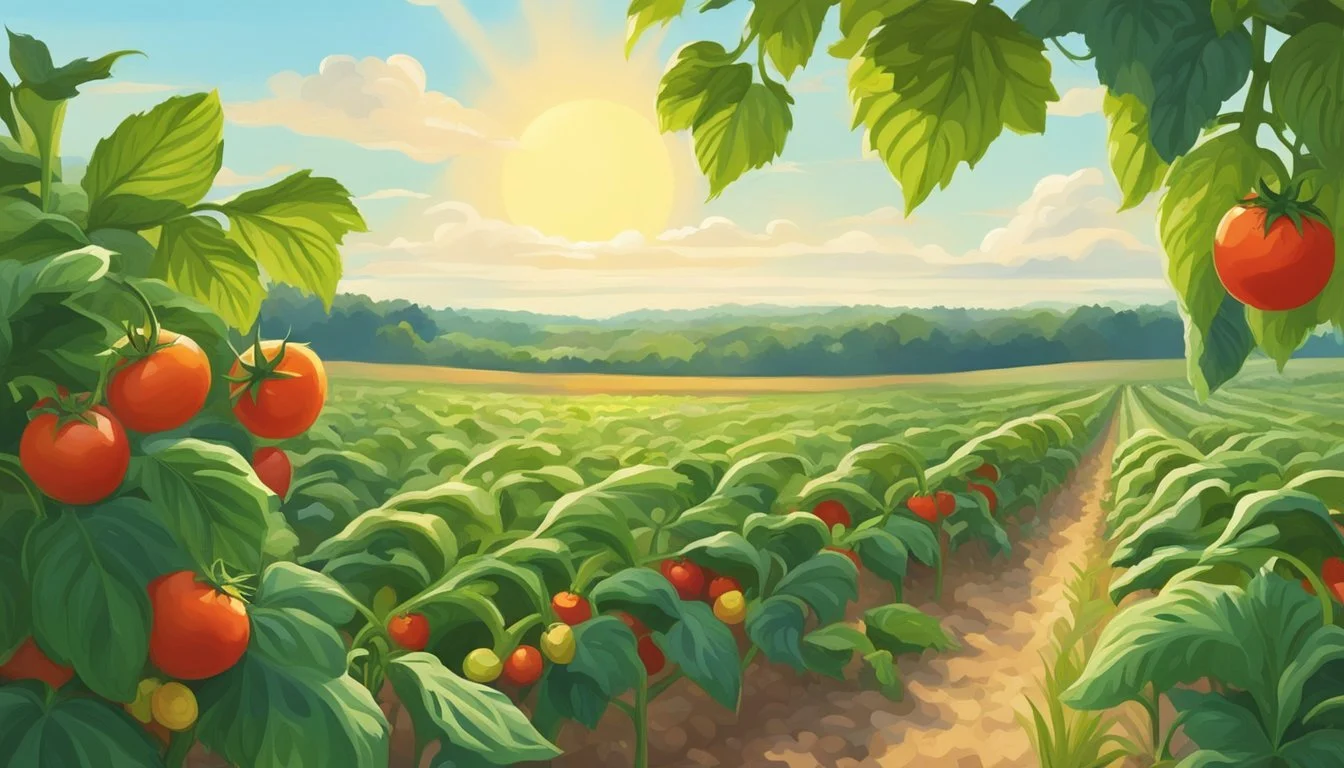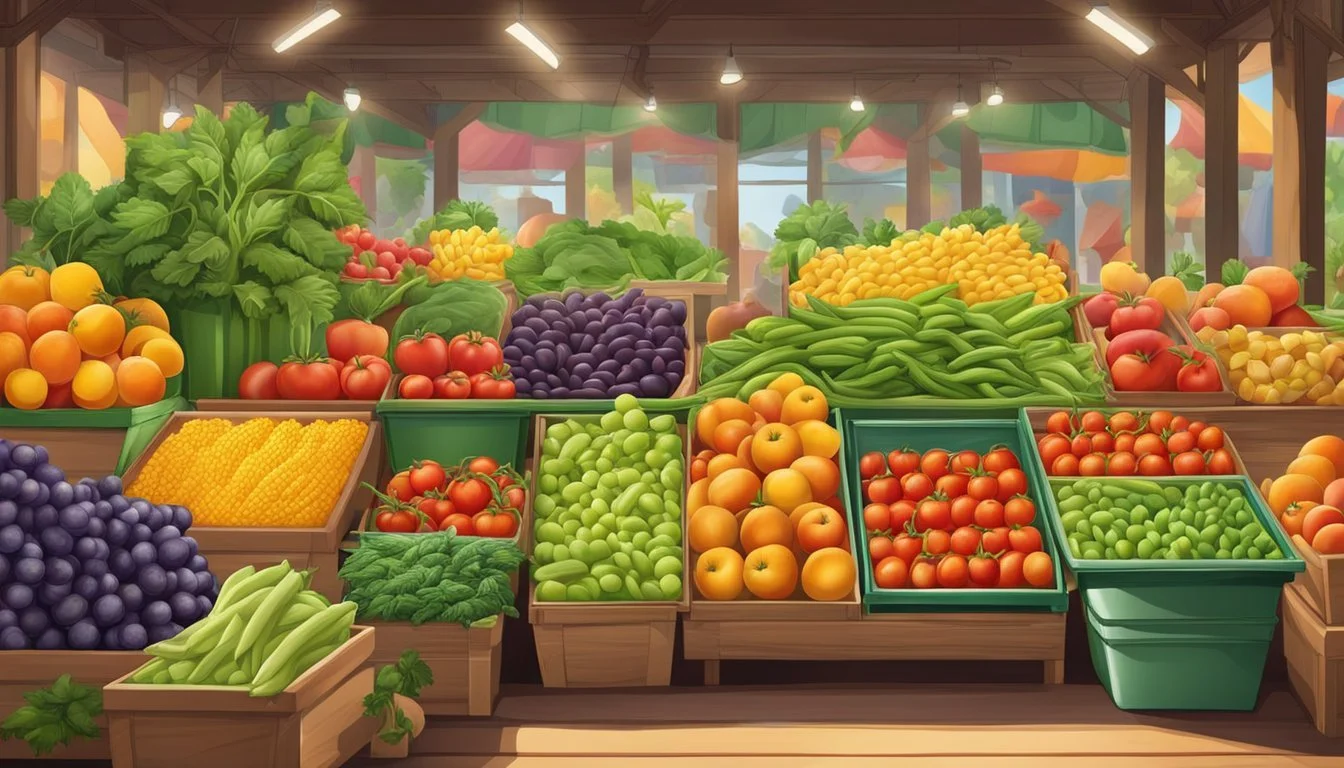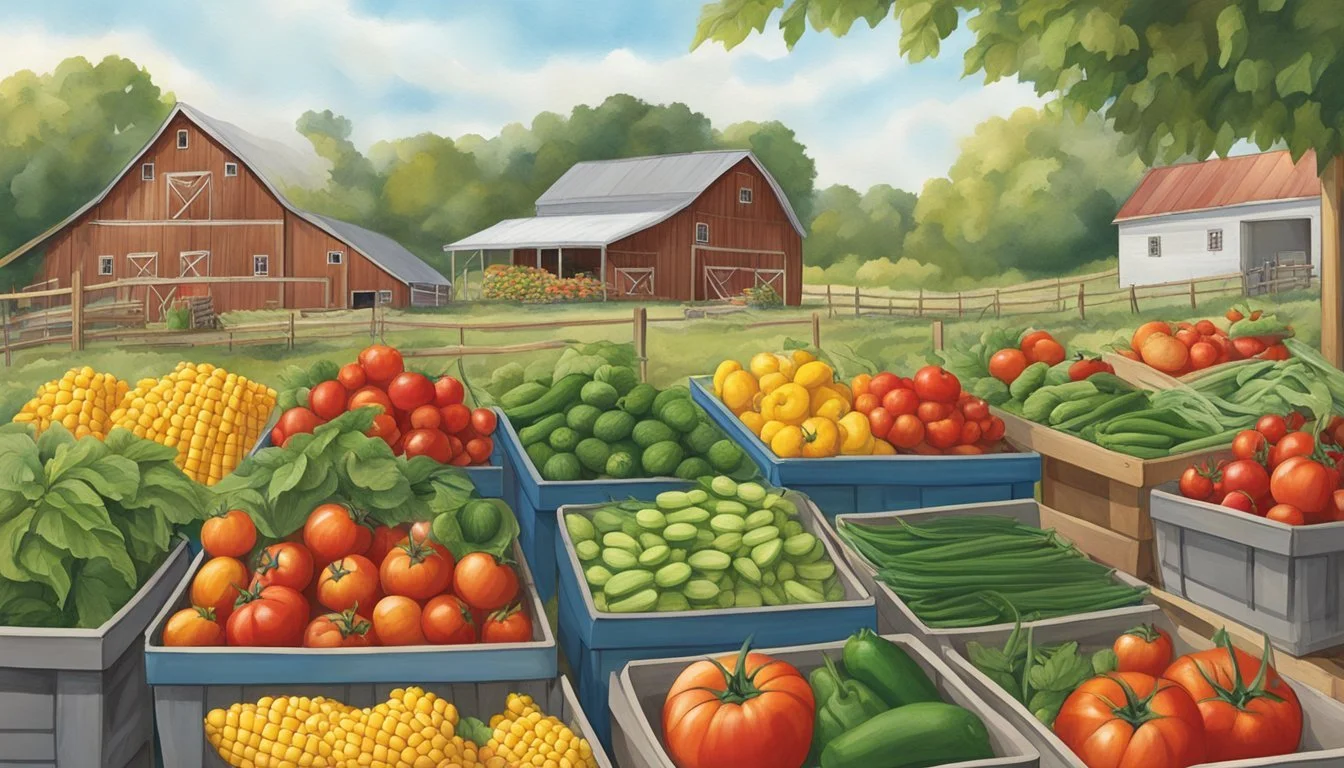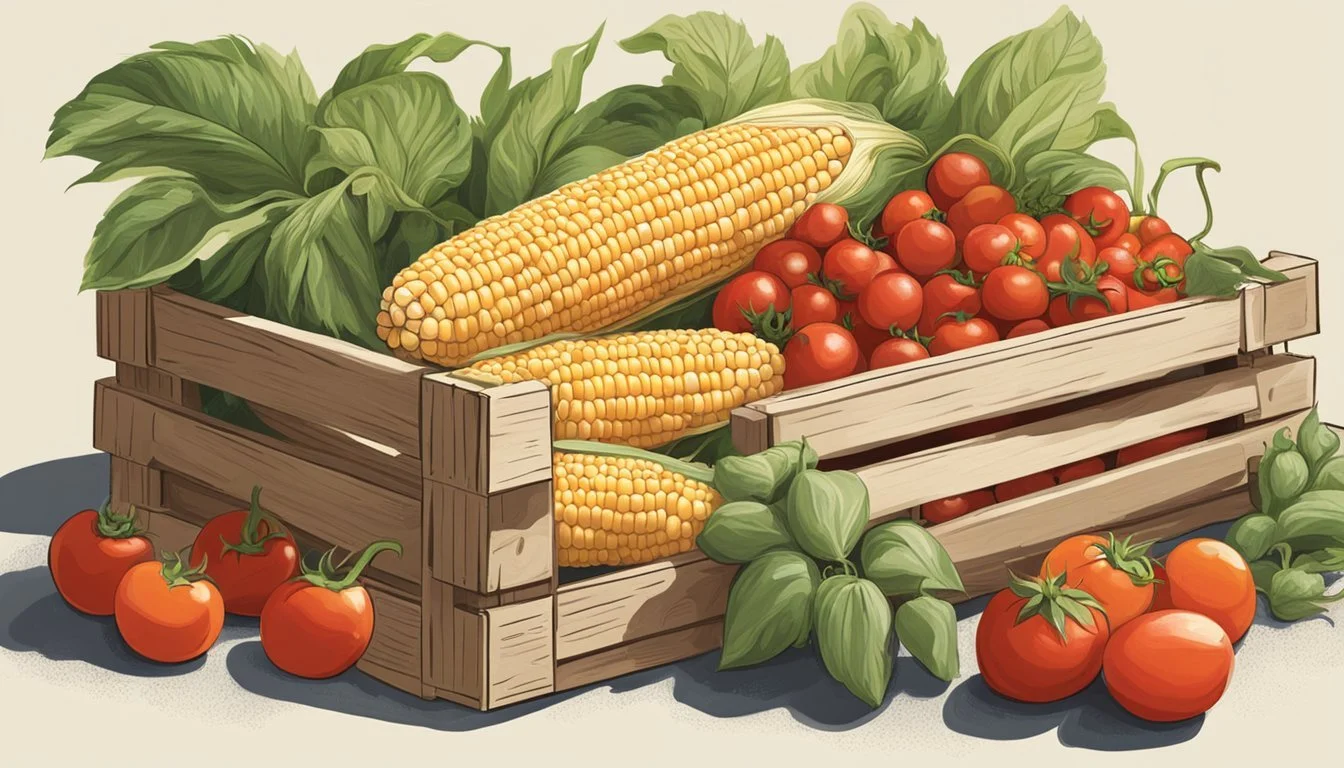Iowa Seasonal Fruit & Vegetables in July
A Guide to Fresh Produce Selection
This Article is Part of our Iowa Seasonal Fruit & Veg Calendar
July in Iowa offers a harvest of vibrant and nutritious produce, which is intrinsic to the region's agricultural identity. During this month, the state's fertile land yields a bounty of both fruits and vegetables, reflecting the peak of summer's abundance. Iowa's farmers' markets and grocery stores become colorful tapestries woven with the freshest local produce, inviting residents and visitors alike to enjoy flavors at their zenith of freshness and nutritional value.
The season's warm temperatures and nurturing sunlight foster a variety of fruits including blueberries (how long do blueberries last?), which are at their juiciest, and other berries that punctuate the landscape with their ripe, summer sweetness. Vegetables too, such as sweet corn, a staple in the Iowan diet, reach their prime, along with tomatoes, cucumbers (how long do cucumbers last?), and bell peppers (What wine goes well with bell peppers?), each bursting with their characteristic flavors and textures.
The regional climate, coupled with the expertise of local farmers, ensures that each fruit and vegetable grown and harvested in July carries the promise of quality and wholesomeness. These seasonal offerings not only contribute to wholesome meals and community gatherings but also support Iowa's agricultural economy, showcasing the rich tapestry of the state's farm-to-table tradition.
Overview of Iowa's Seasonal Produce in July
July in Iowa is prime time for harvesting a variety of fresh produce. The warmer temperatures and long days of summer bring a bounty of fruits and vegetables that are at their peak of flavor and nutritional value. Farmers and gardeners across the state are busy during this time, ensuring that the freshest seasonal offerings make their way to markets and tables.
Fruits:
Summer fruits are a delightful treat in July, with blueberries leading the spectrum of choices available. These small, sweet berries are not only perfect for pies and jams but are also packed with antioxidants. Melons also mature during this month, with cantaloupes and watermelons offering juicy refreshment and a hydrating snack during the hot Iowa summers.
Blueberries
Cantaloupes
Watermelons
Vegetables:
July sees a surge in various vegetable harvests. Sweet corn, an Iowa staple, is abundant and at its sweetest, making it a must-have at any barbecue or summer gathering. Zucchini (What wine goes well with zucchini?) and cucumbers also thrive in July's heat, versatile for both cooking and fresh salads. Leafy greens continue to grow, although the warmer weather may affect their abundance. Root vegetables like beets (how long do beets last?) and carrots are also readily available, ideal for roasting or as part of a colorful summer slaw.
Sweet Corn
Zucchini
Cucumbers
Beets
Carrots
For those looking to enjoy fresh produce, July's offerings provide an exceptional range of flavors and textures. The produce listed is not exhaustive but offers a glance at what one can expect from Iowa's fertile lands during this month. Shoppers are encouraged to explore local farmers' markets for the freshest in-season produce.
Summer Fruits Available in Iowa
During the month of July, Iowa provides an abundance of summer fruits that are ripe and ready for enjoyment. From the juicy burst of berries to the sweet flesh of stone fruits and refreshing bites of melons, Iowa's summer harvest is rich in variety and flavor.
Berries
Blueberries: They are typically at their peak from May through July.
Raspberries: This fruit also falls within the summer harvest timeframe, being readily available.
Blackberries: (how long do blackberries last?) Joining the berry group, blackberries offer their distinctive sweet and tart flavor to the season's palette.
Strawberries: Though the strawberry season starts in June, they can still be found fresh in early July.
Stone Fruits
Peaches: Iowa's peaches begin to ripen in July, offering a succulent and fuzzy treat.
Cherries (how long do cherries last?): Sweet cherries are ready to be picked in the warmer months, with July being a prime time.
Melons
Watermelon: Nothing epitomizes summer like a crisp, cool watermelon, coming into season now.
Cantaloupe: This melon’s sweet, orange flesh becomes available, adding to the diverse array of Iowa’s summer produce.
Melons: A broader category, including a variety of melons, is now entering the stage of optimal ripeness and flavor.
Summer Vegetables Harvested in Iowa
In July, Iowa's fertile soils yield a bounty of summer vegetables, with farms and gardens offering a variety of fresh picks ripe for the season.
Leafy Greens
Kale: This nutrient-rich green thrives in Iowa's summer, with harvest typically in full swing.
Lettuce: Various types of lettuce peak during early summer, providing crisp leaves for salads.
Spinach: Delicate spinach leaves are best harvested early in the morning to retain freshness and flavor.
Nightshades
Tomatoes: Iowa gardens are dotted with an array of tomato varieties, from heirlooms to cherries, all bursting with flavor.
Peppers: Sweet bell peppers and spicy varieties add color and heat to the summer harvest.
Eggplants (What wine goes well with eggplant?): Grown in warmer conditions, eggplants reach their prime in Iowa during the midsummer months.
Gourds and Squashes
Zucchini: A summer squash staple, zucchini is prolific and versatile, often harvested continuously.
Summer Squash: Similar to zucchini, other summer squashes are also abundant, with yellow varieties being popular.
Cucumbers: Crisp and cooling, cucumbers are harvested throughout the summer, perfect for salads and pickling.
Preparing and Storing July's Harvest
Iowa's July harvest offers a range of fresh produce that requires proper handling and storage techniques to ensure the longevity and flavor of the fruits and vegetables. Appropriate methods of preservation can further extend their use well beyond the summer months.
Handling Techniques
After harvesting, individuals should wash fruits and vegetables under cool, running water and dry them thoroughly to prevent spoilage. Fruits like blueberries and vegetables such as cucumbers should be handled gently to avoid bruising, which can accelerate decay. Vegetables destined for salads need to be crisp, while fruits for baking can be slightly softer.
Storage Tips
Optimal storage of July's produce varies between refrigeration and countertop storage, depending on the specific variety:
Refrigerate: Cucumbers, leafy greens, and bell peppers should be stored in the fridge to maintain freshness. They are best kept in the crisper drawer to retain moisture and crispness.
Countertop: Tomatoes and stone fruits, until ripe, should sit on the counter, as cold temperatures can diminish their flavor and texture. Once ripe, they can be moved to the fridge if not consumed immediately.
Preservation Methods
For long-term use, several preservation methods are employed:
Freezing: Berries and sweet corn can be frozen for later use. They should be cleaned, blanched if necessary, and stored in airtight containers or freezer bags.
Jam: Transform berries into jam for a spread that captures the essence of July all year round.
Salsa: Tomatoes and peppers can be made into salsa, which can then be canned for storage.
Pickles: Cucumbers can be turned into pickles through a pickling process which involves vinegar and canning for shelf stability.
By applying these techniques, Iowa's July bounty can be savored in a variety of dishes, from fresh salads to hearty baked meals, and through different seasons.
Gardening Tips for Iowa's July Produce
In Iowa, July brings the heat and a diverse array of produce thriving in the peak of summer. Gardeners should focus on pest and disease management, as well as optimizing growth conditions, to ensure bountiful harvests.
Pest and Disease Management
In July's warm climate, pests such as Japanese beetles, bean beetles, and squash vine borers become active. Gardeners should regularly inspect their plants, especially those in Hardiness Zone 5, for any signs of infestation.
Deer, rabbits, and squirrels pose a threat to gardens. Installing fencing or nets around garden areas can deter these animals.
Maintain pest management by introducing beneficial insects like ladybugs, or applying insecticidal soaps targeted at aphids and spider mites.
For common diseases like blight or powdery mildew, one should remove affected plant parts immediately and apply fungicides as necessary to prevent further spread.
Optimizing Growth Conditions
Proper care in July is crucial for the development of Iowa's produce. Providing the right fertilizer and considering space-saving techniques such as vertical gardening can enhance plant health and yield.
Apply a balanced fertilizer according to the specific needs of each plant. This usually involves a higher amount of phosphorus and potassium to support flowering and fruiting.
Pruning is essential to maintaining healthy growth. Remove dead or overgrown limbs to ensure sunlight and air circulation, which minimize disease risk.
For gardeners with small space, vertical gardening techniques for crops like cucumbers and pole beans are effective for maximizing yield.
Maintain consistent watering, especially during dry spells, to prevent stress and to support the development of produce like peppers and tomatoes.
By deploying effective pest and disease management strategies and optimizing growth conditions, gardeners in Iowa can make the most of their July gardens.
Health Benefits of Seasonal Eating
Eating seasonal fruits and vegetables in Iowa during July offers numerous health benefits. These items are typically harvested at their peak ripeness, which not only ensures the brightest, most vibrant flavors but also maximizes nutritional content. Fresh produce that hasn't traveled far from farm to table is more likely to retain its full spectrum of essential vitamins and minerals.
Freshness: Seasonal fruits and vegetables are often fresher, having been picked within hours or days of purchase. This not only ensures a firm texture but also helps to preserve nutrient integrity, which can be lost over time with extended storage and transport.
Nutritional Value:
Bright and Plump Produce: These traits are indicative of fresh, nutrient-rich fruits and veggies. Seasonal items often exhibit these characteristics, signaling they're packed with antioxidants and phytonutrients.
Firm Vegetables: Often indicate they're harvested at the correct time for maximum taste and dietary fiber content.
Versatility: Seasonal produce is incredibly versatile in culinary uses. From fresh salads to grilled vegetables, (What wine goes well with grilled vegetables?) there are countless ways to incorporate these items into a diet, making meals more interesting and nutritious.
Economic and Environmental Benefits: Choosing seasonal items not only supports local agriculture but also reduces the carbon footprint associated with long-distance food transport. Consequently, consumers often enjoy better pricing when purchasing in-season goods.
In summary, seasonal eating aligns with a healthier lifestyle by offering produce that is more nutrient-dense, supports local economies, and is better for the environment.
Iowa's Seasonal Recipes and Dishes
In July, Iowa boasts a rich variety of fruits and vegetables that provide the perfect foundation for an array of seasonal dishes. The state's local produce can inspire a confident home cook or professional chef to explore new culinary creations rooted in freshness and regional flavor.
Salads
They often start with tender greens, such as spinach and leaf lettuces, which are abundant in July. Adding sliced radishes, cucumbers, and bell peppers can build layers of crispness and color. Topping these salads with a sprinkle of goat cheese and a handful of blueberries or raspberries creates a delightful balance of savory and sweet flavors.
Roasted Beets
A simple yet delectable way to savor Iowa's beet harvest is through roasted beets. When roasted, beets become sweet and tender, making them an excellent side dish or a flavorful addition to salads. Their rich, earthy essence also stands out in puréed soups, offering a hearty and nourishing option.
Soups
Chilled cucumber soup can provide a refreshing remedy to the summer heat. Combining pureed cucumbers with yogurt, garlic, and fresh herbs yields a smooth and revitalizing dish.
Desserts
Desserts like berry compote embrace the season's sweetness and are versatile in their use. Cooked down with a touch of sugar and lemon, berries can enhance cheesecakes or serve as a stand-alone dessert topped with a dollop of whipped cream.
Compote
For a rustic touch, one might consider stone fruits such as cherries or peaches for a compote, which pairs wonderfully with grilled pork or as a topping for ice cream.
When it comes to savory or sweet, Iowa in July offers a diverse palette from which chefs can draw inspiration, turning the state's seasonal produce into culinary delights.
Seasonal Food Events and Activities in Iowa
July in Iowa brings an abundance of fresh produce and with it a variety of seasonal food events celebrating the local bounty. Farmers' markets across the state boast a vibrant selection of summer fruits and vegetables. Visitors can enjoy the freshest corn, as Iowa’s corn is at its peak in this warm month.
One of the state’s signature events is the Sweet Corn Festival. Iowans and visitors alike can indulge in freshly picked, sweet and juicy corn on the cob. It's a chance to experience the local heat-tolerant crops that thrive in Iowa's summer climate.
Apart from enjoying the produce, visitors can engage in activities like corn mazes, which begin to open late July as a prelude to fall. These mazes offer an interactive way to celebrate Iowa’s agriculture while also offering a fun challenge for families and groups.
Farm Tours: Several farms in Iowa also provide educational tours where visitors can learn about sustainable farming practices and see the cultivation process first-hand.
Cooking Demonstrations: Many markets and festivals host cooking demonstrations, where local chefs showcase how to prepare seasonal produce like zucchini, peppers, and tomatoes that are abundant in July.
Pick-Your-Own Farms: These farms invite the public to come and pick their own fruits and vegetables, an enjoyable activity that connects people directly with their food source.
Iowa’s July food events not only serve as an opportunity to savor the state's fresh produce but also highlight the importance of supporting local agriculture and understanding the seasonality of food. As the state transitions from the heat of summer to the cooler days of fall, these events offer a glimpse into Iowa’s rich agricultural heritage.










